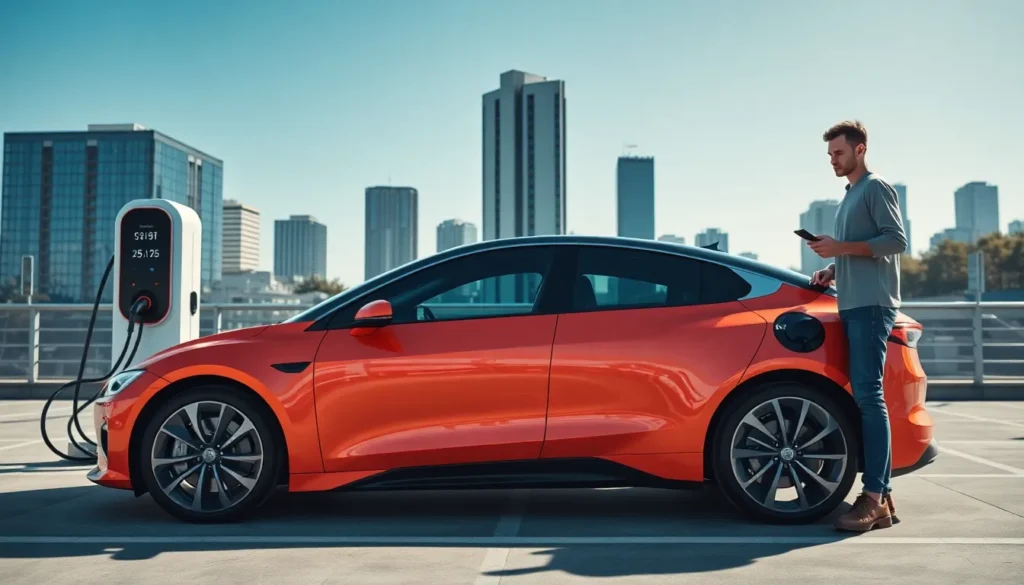As the world shifts towards sustainable transportation, electric vehicles (EVs) are at the forefront of this revolution. Future-proof EV technology promises to enhance performance, efficiency, and user experience while addressing the pressing challenges of climate change. Innovations in battery technology, charging infrastructure, and smart features are set to redefine how people interact with their vehicles.
With advancements like solid-state batteries and ultra-fast charging, the landscape of EVs is rapidly evolving. Manufacturers are not just focusing on current demands but also anticipating future needs, ensuring that today’s investments lead to tomorrow’s breakthroughs. This article delves into the exciting developments in future-proof EV technology, exploring how these innovations will shape the automotive industry and contribute to a greener planet.
Table of Contents
ToggleOverview of Future Proof EV Technology
Future proof EV technology focuses on advancements that ensure electric vehicles remain relevant and effective as consumer needs evolve. Key areas include battery improvements, charting pathways for sustainability and efficiency.
Battery Technology
- Solid-state Batteries: Solid-state batteries enhance energy density and safety, reducing risks of fire and increasing range up to 500 miles on a single charge.
- Lithium-Sulfur Batteries: Lithium-sulfur batteries promise lower costs and higher capacity, targeting improvements in energy output and longevity.
- Recycling and Reuse: Battery recycling minimizes environmental impact by allowing components to re-enter the supply chain.
Charging Infrastructure
- Ultra-fast Charging Stations: Ultra-fast charging can replenish up to 80% of an EV’s battery in 15 to 30 minutes, providing convenience comparable to traditional refueling.
- Wireless Charging: Wireless charging pads enable seamless energy transfer, delivering power without the need for plug-in connections.
- Smart Grid Integration: Smart grid technology allows charging schedules to optimize energy usage and reduce costs during peak hours.
Smart Features
- Vehicle-to-Grid (V2G) Technology: V2G technology empowers EVs to return energy to the grid, enhancing overall energy management and stability.
- Autonomous Drive Capabilities: Advanced sensors and AI improve navigation and safety, paving the way for fully autonomous EVs.
- Connected Ecosystems: Integration with mobile apps and IoT devices provides real-time data on battery status, charging locations, and vehicle performance.
Sustainable Materials
- Bio-based Components: Utilizing bio-based materials for vehicle interiors reduces the carbon footprint while promoting sustainability.
- Recyclable Fabrics: Employing recyclable materials in upholstery supports an eco-friendly approach to manufacturing.
Future proof EV technology underscores the importance of innovation and sustainability in the automotive sector, ensuring electric vehicles meet future demands efficiently and responsibly.
Key Innovations in EV Technology

Advancements in electric vehicle (EV) technology focus on innovative solutions that enhance performance, efficiency, and sustainability. Two key areas driving this evolution are battery advancements and charging solutions.
Battery Advancements
Battery technology plays a critical role in EV development. Solid-state batteries offer improved energy density, enabling longer driving ranges and shorter charging times. Lithium-sulfur batteries show promise for higher capacity and lower costs. Increasing emphasis on battery recycling programs reduces environmental impacts. Innovations in battery management systems monitor performance, extending lifespan and enhancing safety. Examples of successful applications include Tesla’s usage of advanced battery chemistry and companies like QuantumScape working on solid-state formulations. These advancements position manufacturers to meet evolving consumer demands.
Charging Solutions
Charging infrastructure innovations significantly enhance convenience and efficiency for EV users. Ultra-fast charging stations provide rapid refueling, allowing drivers to recharge in 15-30 minutes. Wireless charging technology simplifies the charging process, eliminating the need for physical connectors. Smart grid integration optimizes energy distribution, reducing costs and improving access. The development of public charging networks, such as those by ChargePoint and Electrify America, expands refueling options for users. Strategic placement of charging stations along major routes ensures greater accessibility, promoting wider EV adoption. Air quality improvement and reduced range anxiety directly benefit from these charging solutions.
Environmental Impact of EV Technology
Electric vehicle (EV) technology significantly reduces environmental impact through various innovative strategies. These advancements contribute to a more sustainable transportation ecosystem.
Carbon Footprint Reduction
Carbon footprint reduction emerges as a primary benefit of EV technology. EVs produce zero tailpipe emissions, contrasting sharply with internal combustion engine (ICE) vehicles. In the U.S., the transportation sector accounts for approximately 29% of greenhouse gas emissions, making EVs a crucial component in addressing climate change (Environmental Protection Agency, 2021). Transitioning to EVs can reduce these emissions by utilizing renewable energy sources for electricity generation. For example, studies indicate that EVs charged with renewable energy can reduce lifecycle emissions by up to 70% compared to gasoline vehicles (ICCT, 2020). Furthermore, manufacturers are increasingly adopting carbon-neutral production processes, further lowering the overall carbon footprint associated with vehicle manufacturing.
Resource Efficiency
Resource efficiency is vital in minimizing the environmental impact of EV technology. Advanced battery technologies, such as solid-state and lithium-sulfur batteries, utilize materials that offer higher energy densities with less environmental strain. For instance, solid-state batteries use lithium, which has a lower impact during extraction if sourced responsibly. Additionally, EVs encourage the development of battery recycling initiatives that reclaim valuable materials and prevent waste. The International Battery Recycling Association indicates that recycling can recover up to 95% of lithium and cobalt from used batteries, driving sustainability and lowering the need for raw material extraction. Efficient energy use within charging infrastructure also enhances resource management, promoting the use of smart grids that optimize energy consumption during peak and off-peak hours.
Through carbon footprint reduction and resource efficiency, EV technology sets a standard for environmentally conscious transportation solutions.
Challenges and Opportunities
The transition to future-proof EV technology presents various challenges and opportunities that shape the industry’s trajectory. Key areas of focus include infrastructure development and market adoption.
Infrastructure Development
Infrastructure development poses significant challenges for widespread EV adoption. Availability of charging stations and the necessity for rapid charge capabilities affect the user experience.
- Expansion of charging networks remains critical. As of 2023, there are over 140,000 public charging stations in the U.S., but the demand continues to grow.
- Ultra-fast charging stations, providing up to 350 kW, can recharge EV batteries significantly within 30 minutes.
- Wireless charging technology enhances convenience, reducing dependency on traditional cables.
- Integration of smart grids facilitates efficient energy distribution, maximizing renewable energy use.
- Local governments and private sectors must collaborate to identify strategic locations for charging stations, boosting accessibility.
Market Adoption
Market adoption of EVs entails challenges but also reveals substantial opportunities for manufacturers and consumers alike.
- As of 2023, EV sales accounted for approximately 7% of all new car sales in the U.S., a percentage projected to increase.
- Consumers require incentives like tax credits and rebates to offset initial costs, promoting sales growth.
- Public awareness campaigns educate potential buyers about benefits, including lower operational costs and government support.
- Advancements in affordable battery technology, like lithium-sulfur and solid-state batteries, help reduce overall vehicle costs, attracting a broader audience.
- Collaboration between manufacturers, energy providers, and policymakers fosters supportive ecosystems that enhance adoption rates.
Future-proof EV technology is set to revolutionize the automotive landscape. As advancements continue to emerge in battery efficiency and charging solutions, electric vehicles will not only meet but exceed consumer expectations. The integration of smart features and connected ecosystems enhances user experience while promoting sustainability.
The commitment to recycling and using sustainable materials further underscores the industry’s dedication to minimizing environmental impact. With ongoing innovations and strategic infrastructure development, the transition to electric vehicles is more than a trend; it’s a necessary evolution for a cleaner, more efficient future. Embracing these changes will ensure that electric vehicles remain a relevant and vital part of transportation for years to come.




